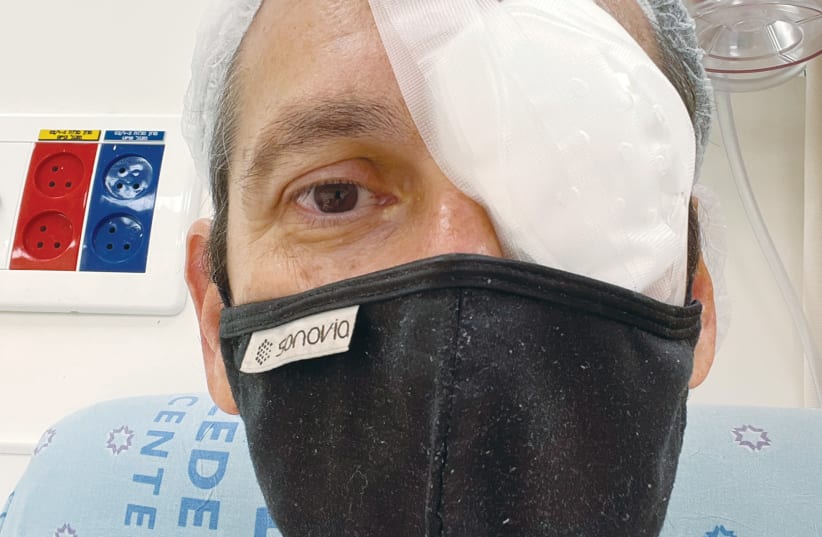As I lay on the operating room table, I began to shake uncontrollably. I don’t know whether it was because the room was cold, my hospital gown was thin, or I was just terrified. Probably some combination of all three.
After two years of suffering with floaters, and a failed attempt at treating them with laser vitreolysis (“Playing Space Invaders with my eyes,” February 11, 2022), I was finally biting the bullet and having them surgically removed.
A quick recap:
Floaters are microscopic fibers within the jellylike vitreous humor of the eye that can clump together, casting shadows on the retina as they bob about. They can be incredibly bothersome: large gray blobs and clouds of thousands of dots and squiggles that bounce around anytime you change your gaze.
It’s not surprising that I was shaking: The surgery I was about to undergo – a vitrectomy – involves drilling three small holes into your eyeballs – one to drain the vitreous fluid, along with any floaters; the second to replace it with a saline solution; and the third for a small light to illuminate the area.
Retinal surgeons are generally very reticent to perform floater-only vitrectomies. There’s nothing actually “wrong” with your eyes, they will argue. The floaters are annoying, yes. Dangerous, not so much. Eye surgery, on the other hand, comes with a whole host of possible complications, including retinal tears and infections. You could even go blind.
Moreover, most everyone who has a vitrectomy will also develop cataracts. That wasn’t a concern for me: It was the cataract surgery I had nearly three years ago that unleashed the floaters in the first place. I also had a posterior vitreous detachment (PVD) in at least one eye, meaning the vitreous gel was no longer connected to my retina, making a tear less likely.
Vitrectomies are among the most common operations retinal surgeons do – just not for floaters. If you need a biopsy to check for eye cancer or there’s a macular hole in the retina that needs repair, the ophthalmologist will readily remove the vitreous.
The nurse covered me in a blanket to help with my shivering. An IV was inserted into my arm – “just in case, although we almost never use it.”
During the procedure, I heard machines whirring and imagined I saw the floaters sucked away. The most uncomfortable part was the needle to anesthetize the eye. After that, I didn’t feel a thing.
Forty-five minutes later, I was done. A patch was affixed, and I was sent home with a backpack full of eye drops.
When my surgeon removed the patch the next day, it was nothing short of a miracle: My vitreous was clear. No floaters at all. There had been no complications, and my vision was 20/20.
I scheduled an appointment to do the other eye.
Even though I knew what to expect, I was shaking all over again for my second surgery. Something could still go wrong.
This surgery, too, went well, with no complications. But when the patch came off, I spied what appeared to be new floaters!
“How can this be?” I asked my doctor, trying to play it cool.
“It’s probably some debris from the surgery,” the doctor replied. “A bit of blood can get in and look like floaters. It will likely resolve in the next few weeks.”
Except that it didn’t.
A month later, the floaters/debris were still careering around. Two months, three months in, no change. I felt deflated.
Then I noticed something unusual. These new floaters were different. Rather than hovering right in the core of the eye, obscuring my vision, they were mostly off to the side.
Could applying a metaphor comparing the core vs the edge help me deal with my situation?
After all, the main part of my vision was still clear. Would it be possible for me to ignore that pesky edge?
THIS IS something I struggle with in many areas, not just my eyes.
Professionally, if I get something wrong with an article I’m writing, it drags me down, even though 90% of the piece – the core – is just fine.
If I have a fight with my wife, I can spiral into depression, even though the spat is just an edge case and the core relationship remains strong.
On vacation, a missed opportunity will gnaw at me, even if the majority of the trip has been wonderful.
Even my cancer has a core vs edge element to it. Yes, I have tumors from my relapsed lymphoma, but they are growing slowly. My overall health remains pretty good.
Sometimes, though, it becomes impossible to dismiss the edge.
One morning, a few months following the vitrectomy that led to that edge debris, I awoke to a burst of new floaters, worse than anything I’d experienced previously. Apparently, my right eye, unlike the left, hadn’t actually developed a PVD yet, and some transparent vitreous had remained, hidden from my doctor. The emergence of a PVD now – brought on, it seems, by a bumpy dune bashing “safari” during our vacation in Dubai – negated all the progress I had made.
Now I had no choice.
I underwent a second vitrectomy on the same eye two weeks ago. My surgeon had to put in stitches which are very uncomfortable, but there was good news when the patch came off this time: He got all the floaters and all the vitreous. There’s something in my far-right periphery, which I hope will go away this time, but it’s still a massive improvement over the floaters that had been blocking my central vision.
I was ecstatic. But even more important: I had learned a valuable lesson along the way about appreciating what I have in the core.
The benefits – for my eyes and for my mental health – are crystal clear. ■
The writer’s book, Totaled: The Billion-Dollar Crash of the Startup that Took on Big Auto, Big Oil and the World, is available on Amazon and other online booksellers. brianblum.com

